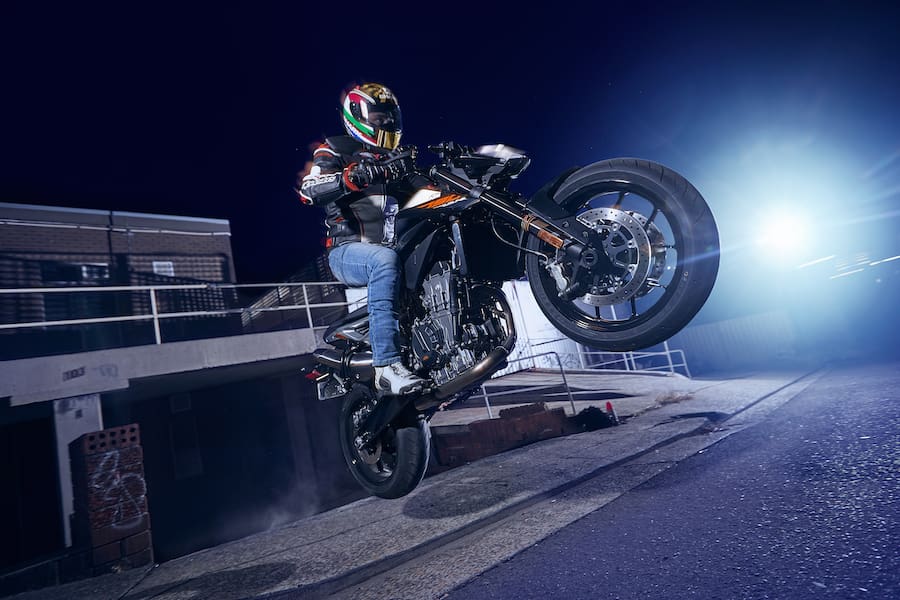I feel extra qualified to test the new KTM 790 Duke, simply because the Duke name and I go way back. I attended the world launch of the very first KTM Super Duke for AMCN in 2003, I owned a single-cylinder Series One KTM 620 Duke for a couple of years (a bike I should never have sold), and my current daily ride is a 1290 Super Duke R Special Edition.
What all three have in common, even across the single and V-twin engines, is a singularly mental attitude. They dare you to get on and ride like most of the KTM staff do – with passion, purpose and a sense of fun, albeit tinged with maniacal hilarity.
Almost anything with a KTM badge is built with a similar DNA, and at the first suggestion of a 790 Duke, I was hooked. Until I realised it was to be powered by one of the most potentially boring powerplants imaginable, a parallel twin.
It’s all about crank offsets with these engines. A standard-offset parallel twin is reliable and all that, but also a dead-set snore in KTM terms.

That engine configuration has starred in so many bland built-to-a-price machines that I just couldn’t feel excited about such an engine powering a KTM Duke, a bike known for barely tamed fuel-burners trying to burst out of tightly built chassis.
I was disheartened. It simply couldn’t work; KTM had sold out, finally. But perhaps the fact the 620 Duke I owned contained a raucous single-cylinder bursting out of its skin every time I kicked it into life should have given me more faith… KTM doesn’t know how to build bland engines.
Pushing the start button for the first time, I was rewarded with the sound of something that wants to rip out of the chassis and explode between your legs with delight.
The LC8c idles like a snorty dragon. It’s no mistake it feels like that, of course. KTM spent many man-hours finding ways to make the budget and size-conscious powerplant fit the KTM mould after trying and failing to create a V-twin small and cheap enough to work in a mid-size machine aimed to compete with three-cylinder machines such as the Yamaha MT-09 and Triumph Street Triple.
A 435-degree firing interval combines with 75-degree offset crank-pins – unlike how other manufacturers are trying to spice up their parallel twins – to emulate KTM’s V-Twin character.
Parallel twins are easier to package into a motorcycle than almost anything else and, balancing challenges aside, if you can make them feel and sound like a V-Twin, why wouldn’t you?
KTM has done a great job here. This bike pokes you in the fun bone like other Orange bikes, and the engine keeps the bike small and compact. I reckon KTM has done such a good job with the motor that it should have kept the Super Duke moniker for this ‘small’ bike. It deserves it.
In doing so, they also kept clean an area that only recent KTMs have managed to iron out – the bottom-end. A mid-sized bike needs to fuel sweetly from deep in the rev basement and into the mid-range to be properly useable, and this parallel twin does that. The fuelling and fly-by-wire throttle response is so sweet off the bottom it makes the useable rev range really broad and the bike therefore feels beyond its cubes. It’s 900-like.
KTM has identified an opening in the middleweight naked market, where it takes on the Triumph Street Triple R and the Yamaha MT-09SP. Here’s how they stack up
KTM Duke 790 $15,495 (plus ORCs)

Triumph Street Triple R $15,850 (plus ORCs)
The new 765 Triumph Street Triples were released a year ago, and at $15,850 (plus on-road costs) for the R version it holds some serious competitive grunt for the Duke. I’m not a huge fan of the Trumpy’s fly-by-wire throttle response, but the bike comes loaded with features and a triple-cylinder engine that is otherwise excellent. With both bikes so similarly priced, riding each is a must before making an educated decision – because the spec sheet alone isn’t enough to separate the two.

Yamaha MT-09SP $13,499 (plus ORCs)
The new SP version of the bike that started the resurgence of the fun, cheap modular mid-size naked is still an absolute bargain, particularly when you factor in its Ohlins shock and claimed 10hp advantage over the 790. Its quickshifter only works for upshifts, though, not down as well as on the 790 Duke. It doesn’t have the same feel as the KTM, but is still a lot of bang for buck. Recent development has delivered a desirable, well-equipped machine at a ridiculous price. It’s tough competition.

Read the full test review in the current issue of AMCN (VOL 67 N0 25) on sale now











